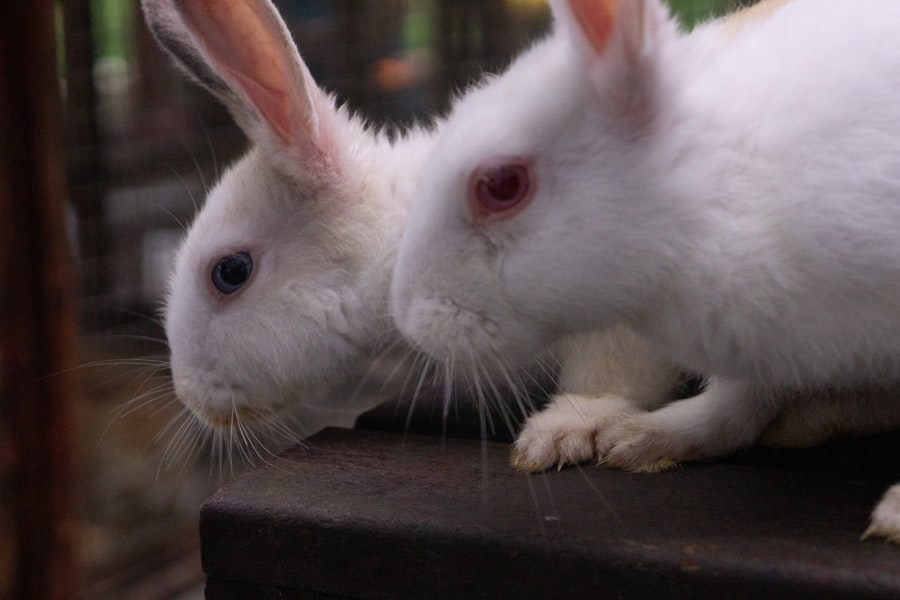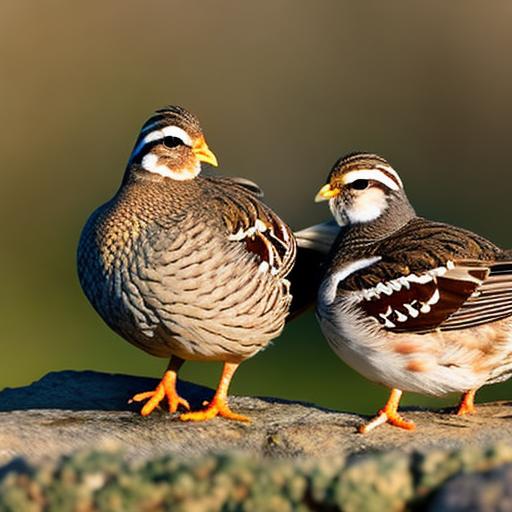Keeping quails and rabbits together can be a rewarding experience for many reasons. Both animals are relatively low maintenance and can be kept in a backyard or small farm setting. Quails are known for their delicious eggs and meat, while rabbits are popular for their meat and fur. By keeping them together, you can maximize the use of your space and resources, as well as provide a more natural environment for both animals. However, it’s important to understand the compatibility, housing, feeding, health, and behavioral considerations when keeping quails and rabbits together to ensure their well-being and safety.
Key Takeaways
- Quails and rabbits can be kept together, but it requires careful planning and consideration of their compatibility, housing, feeding, health, and behavior.
- Quails and rabbits have different housing and enclosure needs, so it’s important to provide separate areas for each species within the same environment.
- Feeding and nutrition for quails and rabbits differ, so it’s essential to provide appropriate diets for each species to ensure their health and well-being.
- Health and safety concerns when keeping quails and rabbits together include disease transmission, aggression, and potential injuries, so regular monitoring and preventive measures are necessary.
- Behavioral considerations for quails and rabbits in the same environment involve understanding their social dynamics and providing enrichment to reduce stress and potential conflicts.
Understanding the Compatibility of Quails and Rabbits
Quails and rabbits can be compatible when kept together if certain conditions are met. Both animals are generally peaceful and non-aggressive, which reduces the risk of them harming each other. However, it’s important to note that rabbits are much larger than quails and may accidentally injure them if not properly supervised. Additionally, quails are ground-dwelling birds, while rabbits are burrowers, so their housing and enclosure should be designed to accommodate both species’ natural behaviors. It’s also important to consider the social dynamics of both animals, as rabbits may become stressed if there are too many quails in their environment, and vice versa. Overall, with proper planning and management, quails and rabbits can coexist peacefully and even benefit from each other’s presence.
Housing and Enclosure Considerations for Quails and Rabbits
When keeping quails and rabbits together, it’s crucial to provide a suitable housing and enclosure that meets the needs of both species. For quails, a secure coop with a solid floor is essential to protect them from predators and provide a safe roosting area. The coop should also have adequate ventilation and lighting to ensure the quails’ health and well-being. Additionally, providing nesting boxes for the quails will encourage them to lay eggs in a designated area, making it easier for you to collect them.
On the other hand, rabbits require a hutch or cage that allows them to move around freely and exhibit natural behaviors such as hopping and digging. The hutch should have a solid bottom to protect the rabbits’ feet and provide insulation from the ground. It’s also important to provide a separate nesting area for the rabbits to give birth and nurse their young. When designing the housing and enclosure for both quails and rabbits, it’s important to consider their individual needs while also ensuring that they can coexist peacefully without causing stress or harm to each other.
Feeding and Nutrition for Quails and Rabbits
Feeding and nutrition are crucial aspects of keeping quails and rabbits together. Quails are omnivorous birds that require a diet high in protein to support egg production and overall health. Their diet should consist of commercial quail feed supplemented with fresh fruits, vegetables, and occasional treats such as mealworms or crickets. It’s important to provide access to clean water at all times, especially during hot weather when quails are more prone to dehydration.
Rabbits, on the other hand, are herbivores that require a diet high in fiber to support their digestive health. Their diet should consist of hay, fresh vegetables, and a small amount of commercial rabbit pellets. It’s important to avoid feeding rabbits foods that are high in sugar or starch, as these can cause digestive issues and obesity. Additionally, providing access to fresh water at all times is essential for rabbits’ health and well-being.
When keeping quails and rabbits together, it’s important to ensure that their feeding areas are separate to prevent competition and potential aggression. Providing multiple feeding stations for both species will help reduce stress and ensure that each animal has access to the appropriate diet for their nutritional needs.
Health and Safety Concerns when Keeping Quails and Rabbits Together
When keeping quails and rabbits together, it’s important to be aware of potential health and safety concerns that may arise. One of the main concerns is disease transmission between the two species. While quails and rabbits are generally healthy animals, they can still carry diseases that may be harmful to each other. It’s important to practice good biosecurity measures, such as regular cleaning and disinfection of their housing and enclosure, as well as monitoring their health closely for any signs of illness.
Another concern is the risk of injury from aggressive behavior or accidental harm. Rabbits may inadvertently injure quails with their large size and strong hind legs if they feel threatened or stressed. It’s important to provide enough space for both species to move around freely without feeling crowded or confined. Additionally, providing hiding spots and enrichment items for both quails and rabbits will help reduce stress and potential conflicts.
Overall, being proactive about health and safety concerns when keeping quails and rabbits together will help ensure the well-being of both species and prevent any unnecessary harm or illness.
Behavioral Considerations for Quails and Rabbits in the Same Environment

Understanding the behavioral considerations of quails and rabbits is essential when keeping them together in the same environment. Quails are social birds that thrive in small flocks, so it’s important to provide them with companionship to prevent stress and loneliness. Additionally, quails are ground-dwelling birds that prefer to forage for food and dust bathe, so providing a suitable substrate such as sand or dirt will allow them to exhibit natural behaviors.
Rabbits are also social animals that benefit from companionship, but they can be territorial and may exhibit aggressive behavior if they feel threatened or stressed. It’s important to introduce new rabbits or quails gradually to prevent conflicts and allow them to establish a hierarchy within their group. Providing hiding spots and separate areas for each species will also help reduce stress and potential aggression.
When keeping quails and rabbits together, it’s important to observe their behavior closely to ensure that they are coexisting peacefully. Signs of stress or aggression such as feather plucking in quails or aggressive chasing in rabbits should be addressed immediately to prevent any potential harm or injury.
Tips for Successfully Keeping Quails and Rabbits Together
Successfully keeping quails and rabbits together requires careful planning, management, and consideration of their individual needs. Here are some tips for ensuring the well-being of both species in the same environment:
1. Provide adequate space: Ensure that both quails and rabbits have enough space to move around freely without feeling crowded or confined.
2. Separate feeding areas: Provide multiple feeding stations for both species to prevent competition and potential aggression over food.
3. Monitor behavior closely: Observe the behavior of quails and rabbits regularly to ensure that they are coexisting peacefully without any signs of stress or aggression.
4. Practice good biosecurity: Regularly clean and disinfect their housing and enclosure to prevent disease transmission between the two species.
5. Provide enrichment: Offer hiding spots, perches, and toys for both quails and rabbits to reduce stress and encourage natural behaviors.
By following these tips and being proactive about the compatibility, housing, feeding, health, safety, and behavioral considerations of quails and rabbits, you can create a harmonious environment where both species can thrive together.
If you’re considering keeping quails and rabbits together, you may also be interested in learning about creating a multi-functional coop that can accommodate different types of poultry. Check out the article “The Chicken Coop Country Diner” on PoultryWizard for tips on designing a coop that can house various types of birds and animals. This article provides valuable insights into creating a versatile and efficient living space for your feathered and furry friends. (source)
FAQs
Can quails and rabbits be kept together?
No, it is not recommended to keep quails and rabbits together. They have different housing and dietary needs, and may not get along well in the same living space.
What are the housing requirements for quails and rabbits?
Quails require a secure and well-ventilated coop with access to a run, while rabbits need a hutch with plenty of space to hop and exercise.
Do quails and rabbits have different dietary needs?
Yes, quails and rabbits have different dietary requirements. Quails need a high-protein diet, while rabbits require a diet high in fiber.
Can quails and rabbits get along if introduced properly?
While it is possible for some animals to get along if introduced properly, it is not recommended to keep quails and rabbits together due to their different needs and behaviors.
What are the potential risks of keeping quails and rabbits together?
Keeping quails and rabbits together can lead to stress, aggression, and potential harm to the animals. Additionally, they may compete for resources such as food and space.
Meet Walter, the feathered-friend fanatic of Florida! Nestled in the sunshine state, Walter struts through life with his feathered companions, clucking his way to happiness. With a coop that’s fancier than a five-star hotel, he’s the Don Juan of the chicken world. When he’s not teaching his hens to do the cha-cha, you’ll find him in a heated debate with his prized rooster, Sir Clucks-a-Lot. Walter’s poultry passion is no yolk; he’s the sunny-side-up guy you never knew you needed in your flock of friends!







